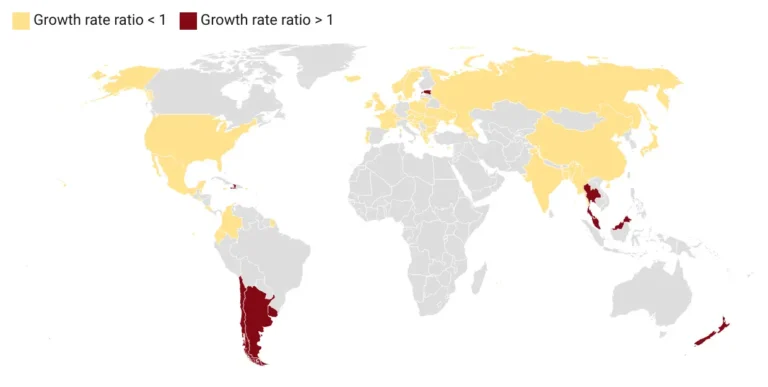‘Tis the season for glad tidings, travel, gatherings — and infectious diseases
December is a busy time for holidays around the globe. From Christmas and New Year’s Eve to Hanukkah, Kwanzaa, and Bodhi Day, billions of people are sharing in religious and cultural traditions. But as the masses travel through busy airports, gather with loved ones, and navigate altered routines, unwanted guests can make an appearance: infectious diseases.
In the northern hemisphere, colder temperatures and snow mark the emergence of common seasonal respiratory infections, such as influenza, COVID-19, and respiratory syncytial virus (RSV). But it’s not just influenza-like illnesses (ILIs) that may be circulating. Over the US Thanksgiving, travelers at the busy Los Angeles International Airport (handling an average of 200,000 people daily) were exposed to measles. Additionally, the UK Health Security Agency (UKHSA) recently issued a warning to holiday travelers for ‘suitcase malaria’ — that is, stowaway mosquitoes in luggage — following a concerning rise in cases last year.
“Over the holidays, many people are traveling in a short period — and sometimes to places where certain infectious diseases are endemic,” says Dr. Hernán Acosta, BlueDot’s Medical Science Liaison. “This is a recipe for transmission.” This edition of Outbreak Insider evaluates the infectious diseases that spread over the holiday season, and how people can protect themselves.
Travel and transmission of infectious diseases
In an increasingly connected world, travel is a major contributor to the spread of infectious diseases. Whether by airplane, train, bus, or car, human movement allows pathogens to travel far and wide — quickly. This phenomenon is not new, from the bubonic plague (“Black Death”) that ravaged Europe between the 14th and 17th centuries to the influenza pandemic in the 19th century and severe acute respiratory syndrome (SARS) in the early 2000s. It was just five years ago now that COVID-19 first emerged — and circulated around the world in a matter of weeks.
The travel that comes with the holiday season is no exception. In the US alone, approximately half of Americans plan to travel over the holidays this year. An estimated 55 million people were expected to travel over the US Thanksgiving holiday period, marking one of the busiest periods in the last quarter-century. In a BlueDot analysis of air travel volume, a total of 78,839,350 travelers are expected to pass through airports in the US and Canada this month, and another 50,769,689 in Europe.

Table: Dr Mariana Torres | Source: BlueDot & OAG | Created with Datawrapper
Pathogens can be transmitted by air, vector, or direct or indirect contact. When traveling, people are often in confined spaces, where proximity and inadequate ventilation can increase the risk for transmission. For instance, an analysis of SARS on commercial airlines in Hong-Kong found that one three-hour flight to Beijing in 2003 was effectively a superspreading event where 22 people within close physical proximity to the patient fell ill. With immense population movement, ILIs and other less-considered infectious diseases can emerge and spread as people gather to take part in the festivities. However, some airports such as Toronto Pearson, have implemented significant measures to enhance ventilation and reduce transmission risks, in collaboration with BlueDot.
Keeping an eye on ILIs
When the holiday season arrives, people often come down with common influenza-like symptoms: malaise, cough, sore throat, and/or fever. Infectious diseases like influenza, COVID-19, and RSV are often the culprits. Drier, cooler air combined with decreased immunity during the winter months means pathogens can stay in the air for longer and spread more easily. This is further complicated by colder temperatures keeping people indoors and in closer proximity.
In BlueDot’s ILI Pulse Report published last week, several trends were noted heading into the thick of the holiday season. Approximately half of the countries in the northern hemisphere have begun observing epidemic growth of seasonal influenza, although some countries, such as the US, Slovenia, and Russia, are reporting delays in activity. In the US, for example, flu hospitalizations are five times lower than they were at the same time last year. However, there is variability year-over-year, and cases are expected to increase.
Generally, COVID-19 activity is declining, with low levels across countries in the northern hemisphere compared to last year. Though COVID-19 trends are less clear, it has been suggested that decreased rates may be attributable to the summer wave, which led to greater population immunity. COVID-19 is being closely monitored worldwide, as is RSV, which has shown early signs of epidemic growth in 12 countries. The UK is on the lookout for a ‘quad-demic:’ rising cases of COVID-19, RSV, the flu, and norovirus.
COVID-19 growth rates from Oct. 20-Nov. 16 vs. Sept. 22-Oct. 19, 2024

Source: BlueDot ILI Pulse, Issue 45, December 4, 2024.
Other ILIs are also circulating, including respiratory pathogens that cause pneumoniae. Mycoplasma pneumonia — walking pneumonia — has been surging recently in North America and China, especially among children. Last week, more than 350 cases of pertussis were reported following the US Thanksgiving, far surpassing the yearly record of 228 cases in 2010. Thankfully, pertussis cases are declining across all states compared to earlier this year. However, declining levels of vaccination coverage and vaccine shortages are contributing to increased cases of ILIs in nations around the globe.
4 Top Takeaways
Transmission through travel. As many gear up to travel for the holidays, whether by planes, trains or automobiles, infectious diseases can come along for the ride. Spread through direct or indirect contact, air, or vectors, pathogens can circulate as people gather in confined spaces.
ILIs are on the seasonal rise. Seasonal influenza, COVID-19, and RSV, along with other common respiratory pathogens (i.e., rhinoviruses, adeniviruses, and adenoviruses) are beginning their seasonal activity, with some variability from last year. Cases are expected to increase during the holidays as 2024 ends and the new year begins.
Imported infectious diseases. Pathogens can spread from endemic to non-endemic countries, and this is particularly concerning during mass travel and gathering times, like the holidays. From measles and mpox to polio and malaria, it’s important to be mindful of illnesses beyond the expected seasonal ones.
Take steps for safe celebrations. When in busy, confined spaces vaccinations, hand hygiene, healthy habits, and PPE like masks play a vital role in reducing the spread of infectious diseases over the holidays, as well as wearing mosquito repellant when traveling to warm destinations.
Measles, mpox, and malaria also pose holiday risks
As mentioned, substantial human movement can bring about infectious diseases that are not endemic to certain regions. Though less commonly considered, these illnesses can spread like wildfire when people travel and gather. For instance, Canada recently saw an imported case of measles that led to an outbreak, affecting approximately 50 people in New Brunswick and 28 people in Ontario. Concerns about additional measles cases are emerging following exposure to an infected individual who travelled internationally to attend a conference in Montreal at the end of last month.
Other imported infectious diseases include mpox, which has been reported in travelers returning to North America, Europe, and Asia from affected nations in Africa. In addition, polio detected in wastewater samples in Europe, including Germany, Poland, Spain, and most recently Finland, have been linked to a strain circulating in Nigeria. Despite being non-endemic to Europe, poliovirus can be imported if it is circulating anywhere in the world. And this is true of many infectious diseases.
Vectors such as mosquitoes can get into suitcases and aircraft, allowing for the transmission of arboviruses, including malaria and dengue, to non-endemic areas. In fact, suitcase or airport malaria is on the rise in Europe, underscoring growing concern about infectious disease transmission and prevention measures related to travel. Mosquito-borne diseases, as well as respiratory viruses, are worrying public health experts in Rome as the city prepares to welcome over 35 million people for Jubilee 2025. And as people jet-set to warmer destinations around the globe, protection against vector-borne diseases is a notable but typically unconsidered part of holiday planning.
Airport malaria cases by airport and country in Europe

Amsterdam airport Schiphol (AMS, n = 3), Brussels airport (BRU, n = 18), Charles de Gaulle airport (CDG, n = 32), Frankfurt airport (FRA, n = 8), Geneva airport (GVA, n = 5), Paris–Le Bourget airport (LBG, n = 3), London Gatwick airport (LGW, n = 2), London Heathrow airport (LHR, n = 2), Luxembourg airport (LUX, n = 5), Madrid–Barajas airport (MAD, n = 1), Marseille Provence airport (MRS, n = 2), Munich airport (MUC, n = 1), Nice Côte d’Azur airport (NCE, n = 1), Paris-Orly airport (ORY, n = 3), Toulouse Blagnac airport (TLS, n = 2).
Source: Hallmaier-Wacker et al., 2024.
Fending off illness during the festivities
There are many preventative steps that can help reduce the risk of contracting an infectious disease over the holidays. As mentioned in past Outbreak Insiders, vaccination is an important measure to build one’s defense system and protect communities, especially those who are vulnerable. With campaigns underway, vaccines for common ILIs like influenza, RSV, and COVID-19 have shown to be effective in preventing illness and the associated serious complications.
Vaccination against other non-endemic infectious diseases should also be considered, particularly if traveling. Travel advisories are available online, such as at the US Centers for Disease Control and Prevention (CDC) website, with information about currently circulating diseases. With this awareness, relevant vaccinations can be sought in discussion with healthcare providers to get protected before departure.
While traveling, be sure to adopt good hand hygiene habits. For instance, using hand sanitizer or handwashing with soap can do wonders to kill germs you may have been in contact with when in public spaces. In conjunction, well-fitting masks also help reduce transmission of respiratory infections. If traveling to warmer destinations, be sure to take measures to prevent mosquito bites, such as mosquito repellant and loose-fitting clothing.
Amidst all the holiday action, healthy habits and routines can get disrupted, wearing immune systems down and increasing susceptibility to illness. Healthy habits, such as getting enough sleep, staying hydrated, and eating nutritious meals while being mindful of alcohol consumption and stress levels can help ward off sickness. And if sickness has struck, it’s best to stay home to rest and recover — and to ensure infectious diseases are not passed along.
“Traveling and gathering over the holidays increases risk for infectious diseases,” says Dr. Acosta. “But with awareness of what’s circulating and tools to combat transmission, we can have a healthy, and happy, holiday season.”
On our radar
Unknown illness in the DRC: More than 30 people have died and 400 have been affected with undiagnosed illnesses in the Democratic Republic of the Congo (DRC). Lab tests are being conducted to identify the disease, which is largely affecting children under 5 years of age. This outbreak is one of several — including mpox — affecting the nation. On 09-Dec-2024, the WHO informed that of 12 samples tested 10 have resulted positive for malaria, and it is likely that the outbreak is due to more than one pathogen. Confirmatory and further tests are still ongoing.
-
Avian influenza around the world: Across the globe, cases of bird flu continue to rise. Last week, Vietnam reported a human case of H5N1 due to infected poultry, which were found deceased at the patient’s home. New Zealand also identified H7N6 in poultry and have taken swift measures to contain the spread. To date, the US has confirmed 58 human cases across seven states, and the Canadian teen hospitalized with H5N1 infection reported in the last Outbreak Insider remains in critical condition.
-
Outbreak Insider takes a holiday: This is the last Outbreak Insider for 2024! Thanks for reading — we look forward to sharing the latest updates on infectious diseases around the globe next year. Wishing you a safe and healthy holiday season!
To stay updated on infectious diseases around the globe as the new year is rung in, sign up here to receive every edition of BlueDot Outbreak Insider.









